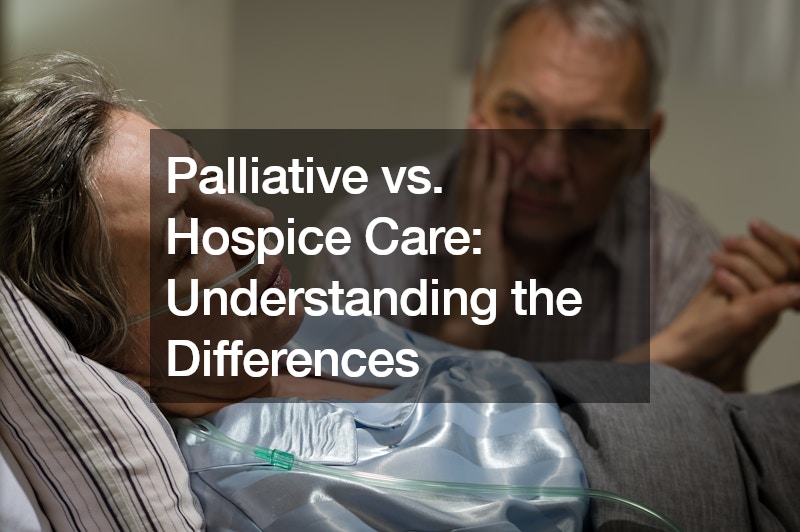When faced with serious illnesses or end-of-life situations, navigating the healthcare system can be daunting. Two terms that often come up in such discussions are “palliative care” and “hospice care.” While they might seem interchangeable at first glance, understanding their differences is crucial for making informed decisions about healthcare options.
This blog post will delve into the disparities between palliative and hospice care, shedding light on their definitions, goals, and common misconceptions.
Defining Palliative Care
Palliative care is often described as an additional layer of support for individuals dealing with serious or life-threatening illnesses. Unlike hospice care, which is limited to the last six months of life, palliative care can be integrated into a patient’s treatment plan at any stage of their illness journey. Its primary goal is to alleviate suffering, manage symptoms, and enhance overall quality of life. Palliative care teams typically consist of healthcare professionals from various disciplines, including physicians, nurses, social workers, and chaplains, who work together to address not only the physical symptoms but also the psychosocial and spiritual aspects of illness.
Understanding Hospice Care
Hospice care, on the other hand, is specifically tailored for individuals with a prognosis of six months or less to live. It involves a shift in focus from curative treatments to symptom management and comfort care. Contrary to common misconceptions, hospice care is not just reserved for the last days or weeks of life; it can provide support and assistance to patients and their families throughout the end-of-life process. Like palliative care, hospice care emphasizes holistic care and often includes a multidisciplinary team to address the diverse needs of patients and their loved ones.
Distinguishing Between Palliative and Hospice Care
One of the key differences between palliative and hospice care lies in their eligibility criteria and timing. While palliative care can be accessed alongside curative treatments and at any stage of illness, hospice care is typically initiated when curative options are no longer pursued, and the focus shifts to end-of-life care. Additionally, palliative care does not have a time limit, whereas hospice care is limited to the last six months of life.
Common Misconceptions
Misconceptions abound regarding both palliative and hospice care. One of the most pervasive misconceptions about hospice care is that it’s solely a place where people go to die. In reality, hospice care can provide invaluable support and comfort to patients and their families during a challenging time. Similarly, palliative care is often misunderstood as giving up on treatment or signaling the end of life. In truth, palliative care aims to improve quality of life and can be provided alongside curative treatments.
Benefits of Palliative Care
One of the primary benefits of palliative care is its focus on improving the quality of life for individuals with serious illnesses. By addressing physical symptoms, managing pain, and providing emotional and spiritual support, palliative care helps patients and their families cope with the challenges of illness. Patients who receive palliative care often experience better symptom management, reduced hospital admissions, and improved satisfaction with their care.
Benefits of Hospice Care
Hospice care offers a range of benefits for patients and their families facing end-of-life situations. One of the most significant advantages is the provision of specialized care tailored to the unique needs of individuals nearing the end of life. Hospice teams focus on managing pain and symptoms, promoting comfort and dignity, and providing emotional and spiritual support to patients and their families. Additionally, hospice care can often be delivered in the comfort of the patient’s own home, allowing them to remain in familiar surroundings surrounded by loved ones.
Deciding Which Care is Right for You
When deciding between palliative and hospice care, it’s essential to consider your current medical condition, prognosis, and goals of care. If you’re dealing with a serious illness but still pursuing curative treatments, palliative care may be the right option for you. Palliative care can help manage symptoms, provide emotional support, and enhance your quality of life while you continue with treatments. On the other hand, if you have a prognosis of six months or less to live and are no longer pursuing curative treatments, hospice care may be more appropriate. Hospice care focuses on comfort and dignity at the end of life, providing specialized support to both patients and their families.
In Summary
While palliative and hospice care share similarities in their holistic approach to patient care, understanding their differences is essential for making informed healthcare decisions. Palliative care offers support and symptom management at any stage of illness, whereas hospice care is specifically tailored for individuals nearing the end of life. Both forms of care prioritize enhancing quality of life and providing comfort to patients and their families during challenging times. By debunking common misconceptions and recognizing the unique benefits of each approach, individuals can better manage serious illness and end-of-life care.
.


